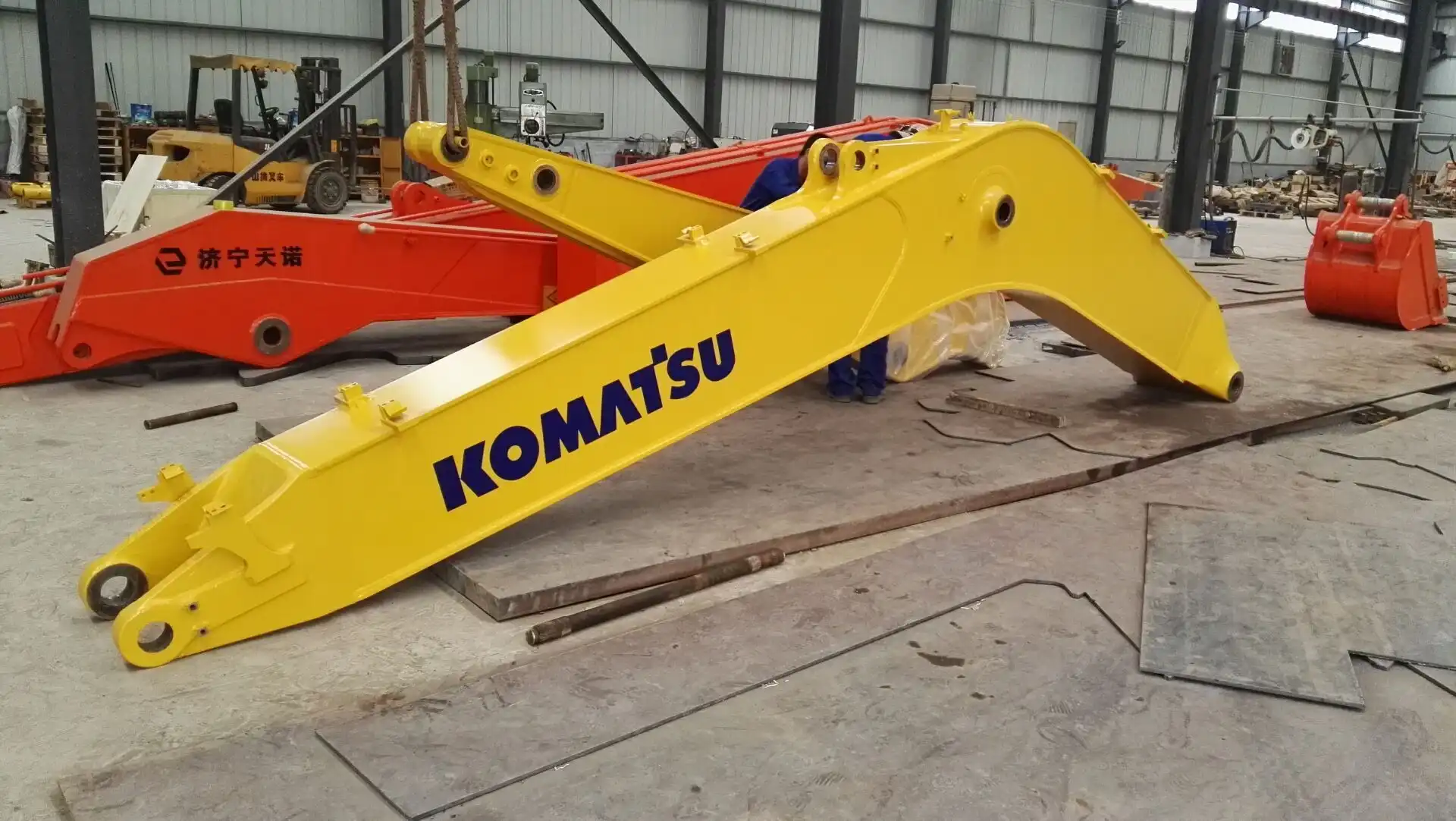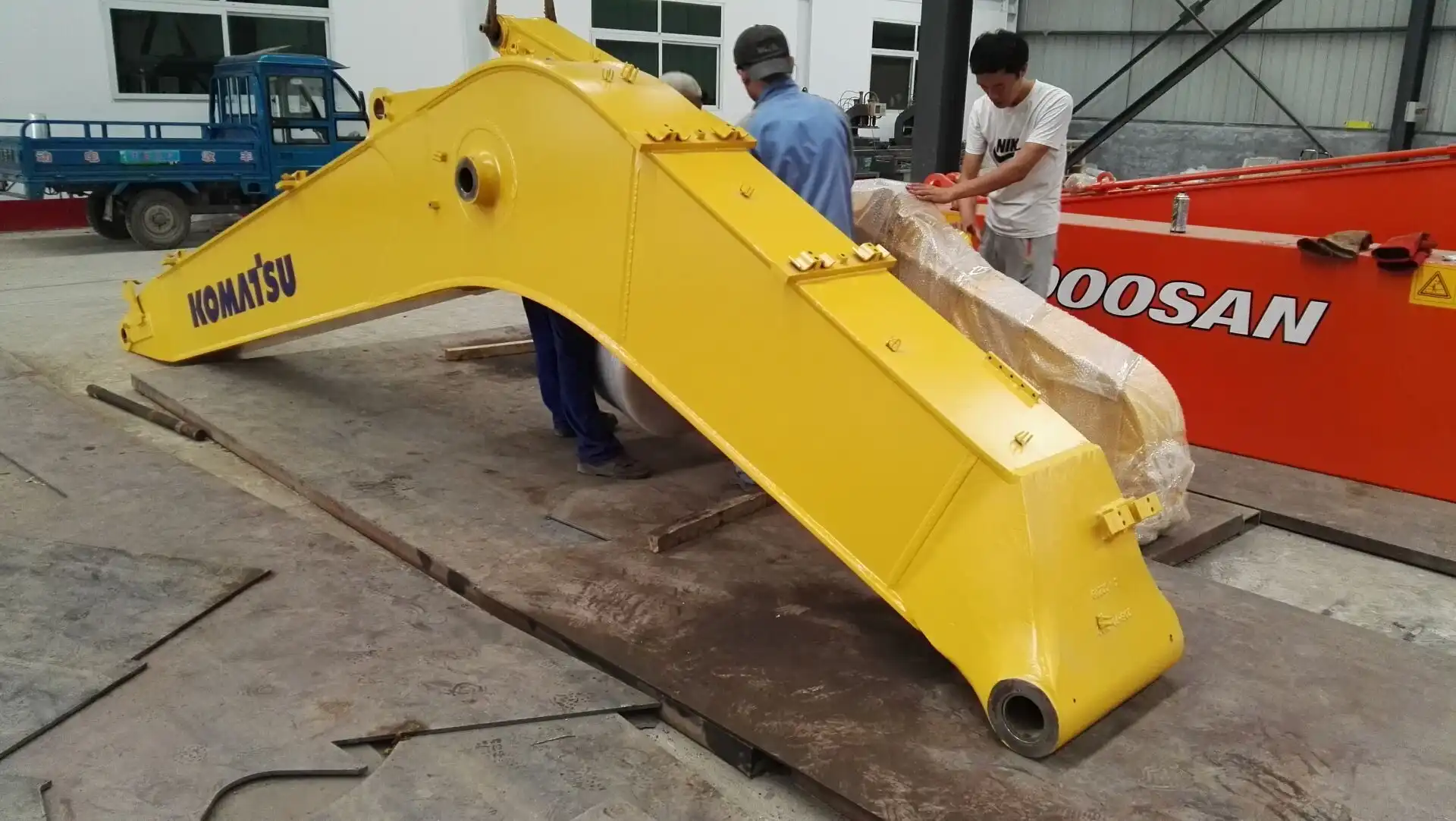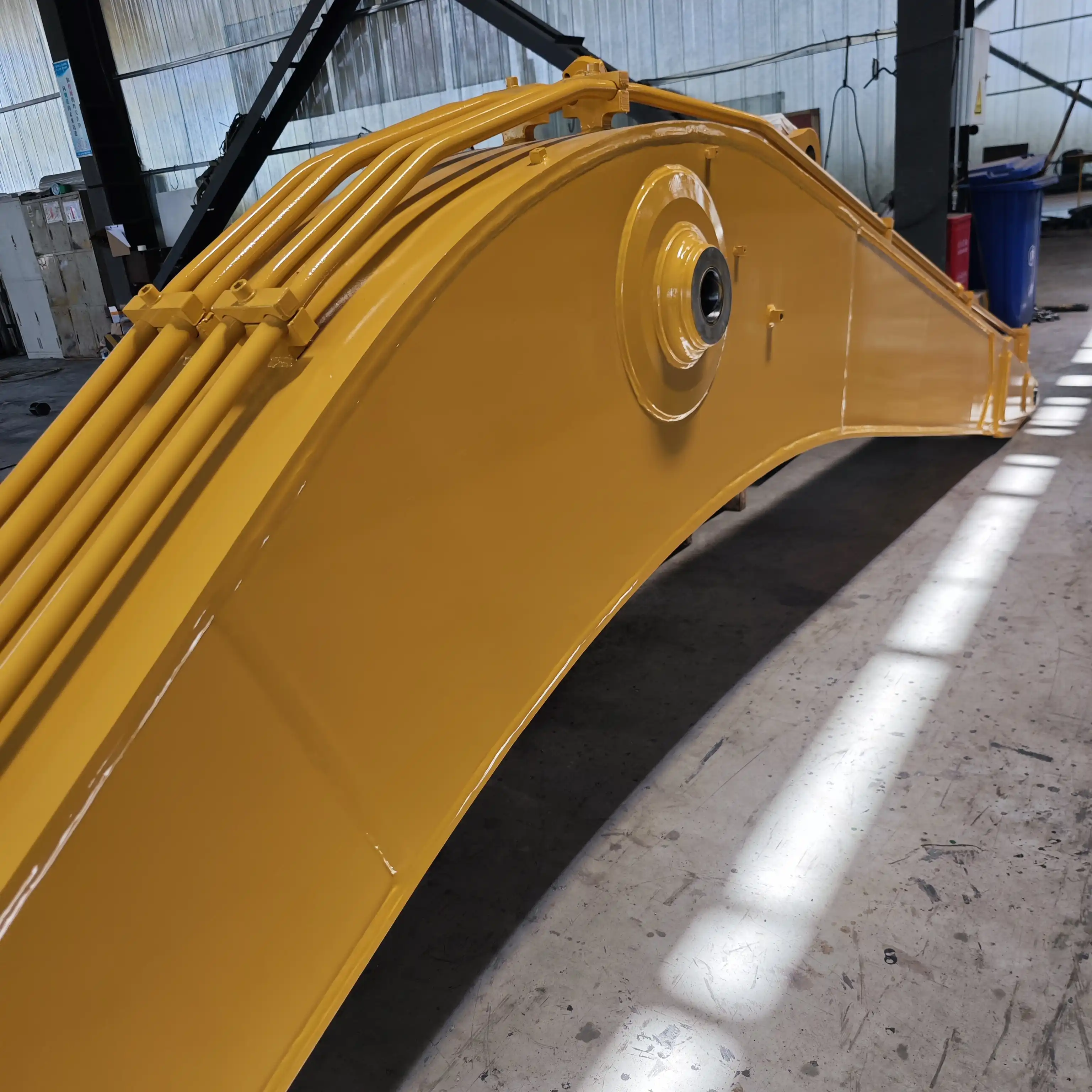What are the configurations of excavator booms?
Excavator booms are essential components that determine the machine's reach, digging depth, and overall functionality. The standard size excavator boom varies across machine classes, but typically falls between 15 to 25 feet in length depending on the excavator's size classification. When selecting the right boom configuration, construction professionals must consider project requirements, working environment, and specific applications. Excavator booms come in various configurations designed to meet different operational needs, with the three main types being mono booms, two-piece booms, and long-reach booms. Each configuration offers distinct advantages in terms of versatility, stability, and performance capabilities. Whether you're involved in railway construction, mining operations, or general excavation work, understanding these boom configurations is crucial for optimizing equipment selection and enhancing operational efficiency. The proper boom choice directly impacts productivity, fuel efficiency, and the range of tasks your excavator can perform effectively across various industrial applications.
Mono Booms

Mono booms, also known as straight booms or standard booms, represent the most common configuration found on excavators across various weight classes. These single-piece boom structures are characterized by their straight design with a slight upward curve.
Design and Structure
The mono boom features a robust, single-piece construction manufactured from high-tensile steel plates welded together to create a box-section design. This configuration provides excellent strength-to-weight ratio while maintaining structural integrity during heavy-duty operations. The standard size excavator arm in mono configuration typically ranges from 15 to 25 feet depending on the machine class, with mid-size excavators (20-30 tons) commonly featuring booms around 18-20 feet in length.
Key structural elements include:
- Reinforced pivot points at the base and stick connection
- Internal cross-bracing for additional strength
- Precision-machined bushings at joint locations
- Hydraulic cylinder mounting brackets strategically positioned for optimal leverage
Applications and Advantages
Mono booms excel in applications requiring consistent power and straightforward digging operations. Their prevalence in the industry stems from their reliability and versatility across common excavation tasks.
Primary applications include:
- General excavation and trenching
- Loading operations
- Foundation work
- Basic demolition projects
- Mass earthmoving
The advantages of mono boom configurations include:
- Superior strength and durability under heavy loads
- Simplified hydraulic systems requiring less maintenance
- Greater breakout force compared to articulated designs
- Enhanced stability during continuous digging operations
- Better weight distribution during lifting operations
Limitations and Considerations
Despite their widespread use, mono booms have limitations that operators should consider:
- Limited flexibility when working in confined spaces
- Restricted working radius compared to articulated designs
- Less versatile in applications requiring complex positioning
- May require more clearance height when working near obstacles
When selecting a mono boom configuration, industry professionals should evaluate the primary work environment and typical applications. The mono boom remains the industry standard for general excavation work where straightforward digging operations predominate.
Two-Piece Booms

Two-piece booms, also known as articulated or knuckle booms, represent an advanced configuration that offers enhanced versatility through an additional articulation point. This design fundamentally transforms the excavator's operational capabilities in complex working environments.
Design and Structure
The two-piece boom consists of a base boom section connected to the excavator body and a secondary boom section attached via an additional hydraulic cylinder. This configuration creates a "knuckle" joint that allows for independent movement of the secondary boom segment. The standard size excavator boom dimensions in two-piece configurations typically feature a base section of 10-15 feet and a secondary section of 8-12 feet, though these measurements vary by machine class.
Key structural components include:
- Reinforced articulation joint with heavy-duty bearings
- Additional hydraulic cylinders for secondary boom control
- Enhanced pivot points to manage multidirectional forces
- Strengthened connection points between boom sections
- Precision-engineered weight distribution systems
Applications and Advantages
Two-piece booms excel in scenarios requiring greater flexibility and precision, particularly in confined spaces or complex working environments.
Primary applications include:
- Urban construction with space constraints
- Railway maintenance and construction
- Underground utility installation
- Working around existing structures
- Operations requiring reaching over obstacles
- Precision grading and finishing work
The advantages of two-piece boom configurations include:
- Enhanced working envelope with greater vertical and horizontal reach
- Improved maneuverability in confined spaces
- Ability to work closer to the machine base
- Versatility in positioning the bucket or attachment
- Reduced need to reposition the excavator during operations
- Greater precision in complex digging tasks
Limitations and Considerations
Despite their versatility, two-piece booms present certain challenges:
- Higher initial acquisition cost compared to mono booms
- Increased maintenance requirements due to additional hydraulic components
- Slightly reduced lifting capacity at full extension
- More complex operator training requirements
- Additional weight affecting overall machine stability in certain positions
For industries such as railway construction and maintenance, the two-piece boom configuration offers particular advantages when working near tracks or existing infrastructure where precision and adaptability are paramount. The ability to work in tight spaces while maintaining productivity makes this configuration increasingly popular across specialized industrial applications.
Long-Reach Booms

Long-reach booms represent specialized configurations designed specifically for applications requiring extended reach beyond standard excavator capabilities. These purpose-built extensions significantly alter the operational parameters of excavation equipment.
Design and Structure
Long-reach booms feature dramatically extended dimensions compared to standard configurations, often doubling or even tripling the reach of conventional systems. While the standard size excavator boom typically extends 15-25 feet, long-reach variants can extend up to 40-100 feet depending on the base machine size and application requirements.
The structural design incorporates:
- Reinforced base boom section with additional bracing
- Extended stick components with progressive taper design
- Counter-weight modifications to balance the extended reach
- Enhanced hydraulic systems with larger cylinders
- Specialized high-pressure hydraulic lines to maintain power at extension
- Additional pivot points to manage distributed loads across the boom assembly
Applications and Advantages
Long-reach booms serve specialized industries where accessing remote or difficult areas is essential to operations.
Primary applications include:
- Dredging operations and underwater excavation
- Bank and slope maintenance along waterways
- Environmental remediation projects
- Demolition of tall structures
- Mining operations requiring reach into deep pits
- Railway embankment maintenance
- Forestry management and clearing operations
Key advantages include:
- Dramatically increased working radius both horizontally and vertically
- Reduced need for machine repositioning during operations
- Ability to work across obstacles like waterways or impassable terrain
- Enhanced safety by keeping the machine at a safe distance from hazards
- Access to otherwise unreachable work areas
- Cost efficiency compared to specialized equipment for certain applications
Limitations and Considerations
Long-reach configurations present significant operational considerations:
- Substantially reduced lifting capacity at full extension
- Increased susceptibility to tipping if not properly counterbalanced
- Higher skill requirements for effective operation
- Reduced maneuverability in confined spaces
- Increased transportation challenges due to disassembly requirements
- Higher acquisition and maintenance costs
- Greater hydraulic power requirements
For industries like mining or waste management, long-reach booms provide essential capabilities for managing operations that would otherwise require additional specialized equipment. The trade-off between extended reach and reduced lifting capacity must be carefully evaluated against project requirements when selecting this configuration.
FAQ
①What is the standard length of an excavator boom?
The standard length varies by machine size, but typically ranges from 15-25 feet for medium-sized excavators in the 20-30 ton class. Compact excavators may feature booms as short as 8-12 feet, while larger machines can have standard booms exceeding 30 feet.
②How do I choose between mono and two-piece boom configurations?
Consider your primary applications—choose mono booms for standard excavation with maximum digging force, or two-piece configurations for operations requiring greater flexibility and working in confined spaces. Two-piece booms excel in urban environments or when working around existing infrastructure.
③What maintenance differences exist between boom configurations?
Two-piece and long-reach booms require more regular maintenance due to additional hydraulic systems, pivot points, and stress distribution. Mono booms typically require less maintenance but should still undergo regular inspection of pivot points, hydraulic seals, and structural integrity.
④Can standard excavator booms be modified for specialized applications?
Yes, many manufacturers offer customization options including reinforced structures for demolition, extended variants for specialized reach requirements, or modified geometries for specific industrial applications. However, any modifications should be performed by qualified engineers to maintain operational safety.
Contact Information
Understanding excavator boom configurations is essential for optimizing equipment selection across construction, mining, railway maintenance, and other industrial applications. The choice between mono, two-piece, and long-reach booms significantly impacts operational capabilities, with each configuration offering distinct advantages for specific work environments and tasks.
Mono booms provide reliability and strength for standard excavation work, while two-piece configurations offer enhanced versatility for complex operating environments. Long-reach booms serve specialized needs where extended access is paramount to project success. For railway construction companies, mining operations, and general contractors, selecting the appropriate boom configuration directly influences productivity, operational efficiency, and project economics.
For more information about high-quality excavator booms, arms, and attachments designed for your specific industry requirements, contact Tiannuo Machinery specialists at rich@stnd-machinery.com. With expertise in manufacturing components compatible with various excavator makes and models, Tiannuo provides customized solutions to enhance your equipment's performance across demanding industrial applications.
References
Construction Equipment Guide (2023). "Excavator Boom Configurations and Their Applications in Heavy Construction."
Journal of Construction Engineering (2024). "Comparative Analysis of Excavator Boom Types and Performance Metrics in Railway Construction."
Mining Technology Review (2023). "Long-Reach Excavator Booms: Applications and Limitations in Modern Mining Operations."
International Journal of Civil Engineering (2024). "Structural Engineering Principles in Excavator Boom Design and Configuration."
Equipment World (2023). "Selecting the Optimal Excavator Boom Configuration for Multi-Purpose Construction Projects."
About Author: Arm
Arm is a leading expert in the field of specialized construction and railway maintenance equipment, working at Tiannuo Company.

